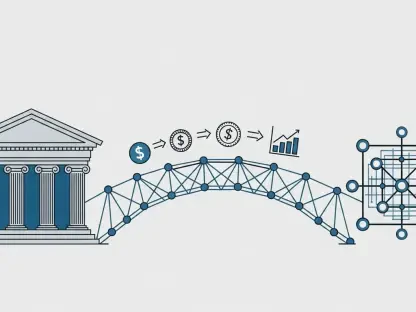In an era where digital transactions dominate global commerce, the complexity of managing payments across diverse systems, currencies, and regulations poses a significant challenge for businesses of all sizes. Payment orchestration platforms have emerged as a transformative solution, streamlining the intricate web of financial operations and enabling merchants to navigate the demands of a rapidly evolving marketplace. This review delves into the technical intricacies, real-world applications, and transformative potential of these platforms, with a spotlight on recent industry collaborations such as the partnership between Doha Bank and PayTabs in Qatar, to uncover how this technology is reshaping the fintech landscape.
Core Principles and Context of Payment Orchestration
Payment orchestration platforms serve as centralized systems designed to manage and optimize the entire payment process, from transaction initiation to settlement. These platforms integrate multiple payment methods, gateways, and providers into a unified framework, reducing the operational burden on merchants and ensuring seamless interactions across global markets. Their rise aligns with the accelerating pace of digital transformation, as businesses increasingly seek tools to handle the complexities of e-commerce and cross-border trade.
The relevance of payment orchestration lies in its ability to simplify fragmented payment ecosystems. By acting as an intermediary between merchants, payment processors, and banks, these platforms enhance transaction efficiency and minimize errors. This capability is particularly critical in regions like the Middle East, where diverse economic landscapes and regulatory environments demand adaptable and compliant solutions.
Beyond efficiency, payment orchestration supports broader industry goals such as financial inclusion and scalability. As businesses ranging from startups to large enterprises adopt digital payment systems, the technology ensures that even smaller players can access sophisticated tools previously reserved for bigger corporations. This democratization of financial technology underscores the growing importance of orchestration platforms in today’s economy.
Key Features and Technical Components
Multi-Currency Payment Gateways
A cornerstone of payment orchestration platforms is the multi-currency payment gateway, which enables transactions across a wide array of international and local payment networks. Supporting major card schemes like Visa and Mastercard alongside regional systems such as QPay in Qatar, these gateways facilitate smooth commerce by handling currency conversions and ensuring compliance with local standards. This functionality is vital for merchants aiming to expand their reach beyond domestic borders.
The technical prowess of multi-currency gateways lies in their ability to manage fluctuating exchange rates and mitigate associated risks. By integrating real-time data feeds, these systems provide accurate pricing and reduce the likelihood of transaction failures due to currency mismatches. Such precision fosters trust among consumers and merchants alike, driving adoption in global markets.
Moreover, these gateways often come equipped with robust security protocols to safeguard sensitive financial data during cross-border transactions. Encryption and tokenization features protect against fraud, ensuring that businesses can operate confidently in diverse regions. This blend of accessibility and security makes multi-currency gateways indispensable to modern payment orchestration.
AI-Driven Transaction Routing
Another pivotal feature is the AI-driven orchestration layer, which optimizes transaction routing to achieve both cost-effectiveness and speed. By analyzing factors such as processing fees, network reliability, and geographic proximity, artificial intelligence algorithms select the most efficient pathways for each transaction. This reduces latency and enhances the overall user experience for merchants and customers.
The adaptability of AI in payment orchestration also addresses dynamic market conditions. For instance, during high-traffic periods, the system can reroute transactions to less congested networks, preventing delays and maintaining service quality. Such responsiveness is crucial for businesses that rely on consistent cash flow and customer satisfaction.
Additionally, AI-driven routing contributes to cost savings by identifying low-fee processing options without compromising reliability. This balance of efficiency and economy empowers merchants to allocate resources more effectively, particularly in competitive sectors like e-commerce where margins are often tight. The integration of machine learning further refines these processes over time, promising even greater precision.
Merchant Tools and Dashboards
Comprehensive merchant tools form an essential component of payment orchestration platforms, offering real-time insights and control over financial operations. Dashboards provide a centralized view of transaction data, enabling businesses to monitor sales, track payment statuses, and identify trends instantly. This transparency is critical for informed decision-making and operational agility.
Mobile apps and settlement solutions complement these dashboards by facilitating on-the-go management and streamlined reconciliation. Merchants can access detailed reports, resolve discrepancies, and manage refunds directly from their devices, reducing dependency on desktop systems. Such flexibility caters to the fast-paced nature of modern business environments, especially for small and medium-sized enterprises.
Beyond functionality, these tools often include customizable features through APIs and software development kits, allowing merchants to tailor payment processes to specific needs. Whether integrating with existing systems or creating bespoke workflows, this adaptability ensures that businesses of varying scales can leverage the full potential of orchestration platforms, enhancing their competitive edge.
Industry Trends and Innovations
The payment orchestration space continues to evolve with notable trends shaping its trajectory, particularly the increasing collaboration between traditional financial institutions and fintech innovators. A prime example is the strategic partnership between Doha Bank, a leading Qatari bank, and PayTabs, a Saudi-based fintech firm, which integrates advanced payment solutions into the bank’s merchant services. This alliance reflects a broader movement toward blending established banking infrastructure with cutting-edge technology.
Another significant trend is the emphasis on digital transformation across regions like the Middle East, where economic diversification initiatives drive the adoption of modern payment systems. Governments and private entities are prioritizing financial inclusion, ensuring that underserved markets gain access to digital tools. Payment orchestration platforms are at the forefront of this shift, offering scalable solutions that bridge gaps in traditional financial services.
Emerging innovations also include deeper integration of advanced analytics and predictive modeling within orchestration systems. These capabilities enable proactive management of transaction risks and customer behaviors, paving the way for more personalized merchant services. As these trends gain momentum, the technology is poised to redefine how businesses and consumers interact in the digital economy.
Real-World Impact and Applications
Payment orchestration platforms have demonstrated substantial impact across various industries, notably e-commerce, retail, and banking. In e-commerce, these systems streamline checkout processes by supporting multiple payment methods, reducing cart abandonment rates, and enhancing customer satisfaction. Retailers, meanwhile, benefit from integrated point-of-sale solutions that sync seamlessly with online transactions, creating a cohesive omnichannel experience.
In the banking sector, the technology facilitates enhanced merchant services, as evidenced by the Doha Bank-PayTabs collaboration in Qatar. This partnership delivers cost-effective, compliant payment solutions to a diverse range of businesses, from startups to large enterprises, through features like multi-currency support and AI-driven routing. The initiative not only boosts operational efficiency but also aligns with national goals for economic growth and sustainability.
The broader societal impact includes fostering financial inclusion by equipping smaller businesses with accessible payment tools. By lowering entry barriers, orchestration platforms enable these entities to participate in the formal economy, contributing to regional development objectives such as Qatar Vision 2030. This transformative potential highlights the technology’s role in shaping inclusive economic ecosystems.
Challenges in Adoption and Implementation
Despite their advantages, payment orchestration platforms face several challenges that hinder widespread adoption. Technical complexities in integrating global and local payment systems often lead to implementation delays, particularly for businesses with legacy infrastructure. Ensuring compatibility across disparate networks requires significant investment and expertise, posing obstacles for smaller merchants.
Regulatory compliance presents another hurdle, as varying standards across jurisdictions demand constant updates to platform functionalities. Navigating these legal landscapes while maintaining operational efficiency can strain resources, especially for firms operating in multiple regions. Harmonizing global practices with local requirements remains a persistent challenge for the industry.
Market barriers, such as resistance to change and limited awareness of orchestration benefits, further complicate adoption rates. Many businesses remain hesitant to transition from traditional systems due to perceived risks or costs. Ongoing efforts to educate stakeholders and demonstrate tangible value are essential to overcoming these impediments and ensuring scalability across diverse markets.
Future Trajectory and Potential Developments
Looking ahead, payment orchestration platforms are expected to evolve with deeper integration of artificial intelligence and machine learning, enhancing predictive capabilities and transaction security. These advancements could lead to even more precise routing mechanisms and fraud detection systems, addressing current limitations and bolstering merchant trust. Such progress will likely redefine operational benchmarks in the fintech sector.
Support for underserved markets is another area of potential growth, with platforms tailoring solutions to meet the unique needs of emerging economies. From 2025 onward, initiatives focusing on micro-merchants and rural businesses could expand access to digital payments, driving economic inclusion. This aligns with global efforts to bridge financial disparities through technology.
The long-term impact may include catalyzing sustainable economic development in regions prioritizing innovation, such as those guided by frameworks like Qatar Vision 2030. As payment orchestration matures, its ability to integrate with other fintech solutions, such as blockchain and digital wallets, could further amplify its influence, shaping a more interconnected and resilient financial landscape.
Final Verdict and Next Steps
Reflecting on this comprehensive evaluation, payment orchestration platforms prove to be a game-changing technology that addresses critical pain points in digital transactions. Their ability to unify complex payment ecosystems, enhance efficiency through AI, and empower merchants with actionable tools marks a significant leap forward for the fintech industry. The real-world impact, exemplified by strategic collaborations like that of Doha Bank and PayTabs, underscores their transformative influence on business operations and economic inclusion.
Moving forward, stakeholders should prioritize addressing integration challenges by investing in user-friendly onboarding processes and robust support systems to ease transitions for businesses. Collaborative efforts between regulators and technology providers could streamline compliance frameworks, reducing barriers to adoption. Additionally, raising awareness through targeted education campaigns will be crucial to highlight the tangible benefits of these platforms.
As the industry progresses, exploring partnerships that extend the reach of orchestration solutions to untapped markets should remain a focus. Innovators and financial institutions must work hand-in-hand to refine AI capabilities and tailor offerings for diverse economic contexts. These steps will ensure that payment orchestration continues to drive efficiency, inclusivity, and sustainable growth in the ever-evolving world of digital finance.









